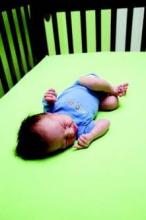Despite a decline in use of soft bedding in infant sleep environments since 1993, more than half of parents continue the practice, putting their children at risk, according to a recent study.
“The use of certain types of bedding in the infant sleep environment is a modifiable risk factor for SIDS [sudden infant death syndrome] and unintentional sleep-related suffocation,” reported Carrie Shapiro-Mendoza, Ph.D., of the Centers for Disease Control and Prevention, Atlanta, and her colleagues.
The American Academy of Pediatrics recommends that soft objects – such as blankets, pillows, soft toys, quilts, comforters, and sheepskin – not be placed in infants’ sleeping areas.
“However, despite such recommendations, the use of bedding over and under the infant for sleep seems to have remained a common practice,” the authors wrote (Pediatrics 2014 [doi:10.1542/peds.2014-1793]).
The authors analyzed data from the annual, cross-sectional National Infant Sleep Position telephone survey data from 1993 to 2010. Among the 18,952 respondents – all of whom were parents of children under 8 months old – 83% were white, 45% had a college education, and 52% had a previous child.
Use of soft bedding dropped from an average 86% in 1993-1995 to 55% in 2008-2010. Thick blankets and quilts/comforters were the most common covers used, and blankets and cushions were the most common items used under infants.
Although use of thick blanket coverings declined from 56% to 27% during that time and quilt/comforter cover use declined from 39% to 8%, the use of blankets and cushions under sleeping infants actually increased, from 26% to 32% and 3% to 5%, respectively.
Risk factors for soft bedding use included lack of college education, nonwhite race, and younger maternal age, with 84% of teenage mothers reporting soft bedding use. In 1993-2010, an average 64% of white parents, 76% of Hispanic parents, and 75% of black parents used bedding.
The study was funded by the National Institutes of Health and the Eunice Kennedy Shriver National Institute of Child Health and Human Development. The authors reported no disclosures.


